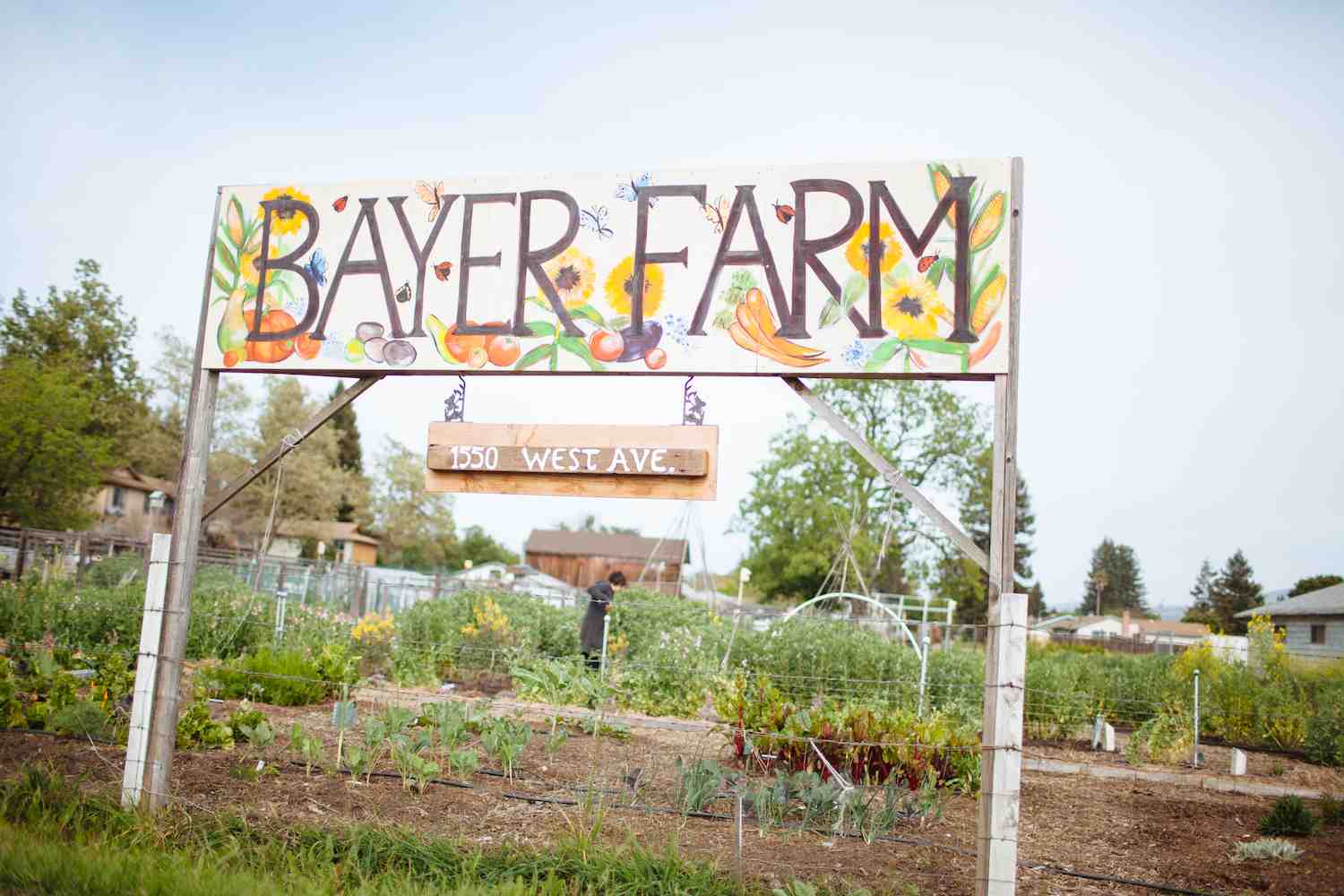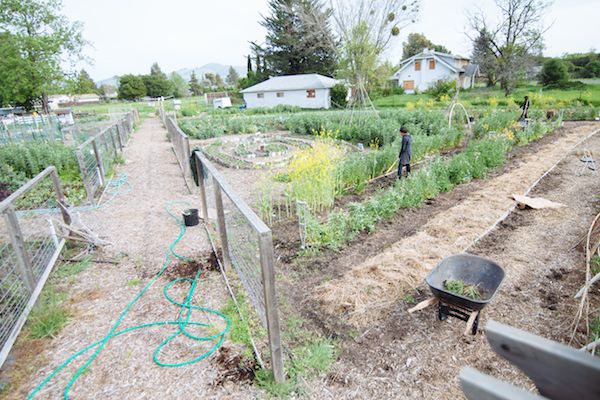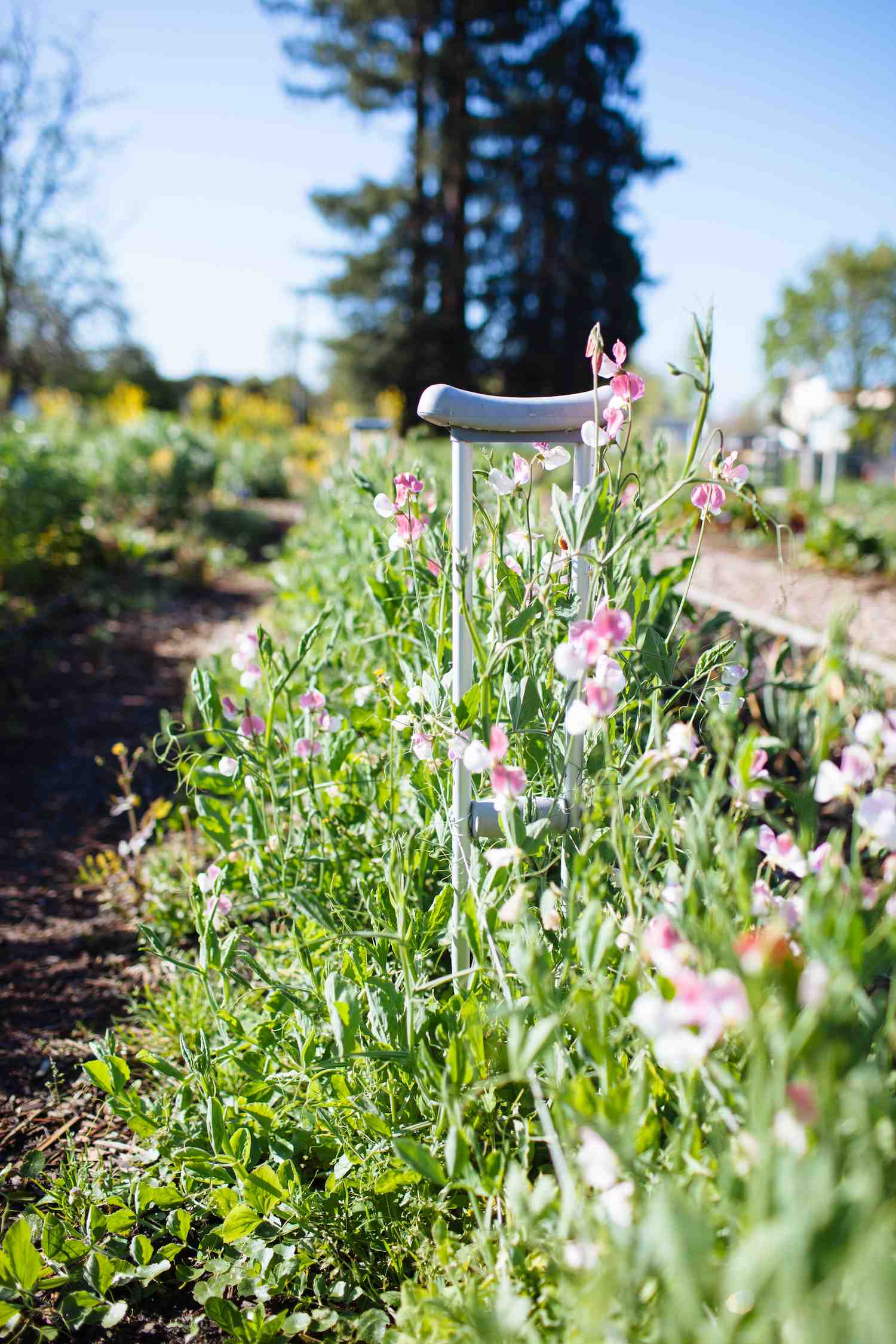It takes a while to find Jonathan Bravo, the coordinator of Bayer Farm, but really—what’s the hurry?
This six-acre swathe of land in the unannexed Roseland section of Santa Rosa is a lovely place to wander around slightly lost. Even before spring’s official launch, it’s clear that the earth is warming to the season here. Lamb’s ear spreads out from the farm’s medicinal garden, a demonstration grape vine has set out leaves, young fruit trees are in flower, fava beans grow tall and green-gray, and California poppies make their natural gold in the native plants area. The farm is a welcome refuge from the apartment buildings and rental homes surrounding it, and the view of Taylor Mountain is superb.
Not that it’s a disappointment to finally find Bravo, a courtly man of a certain age who exudes graciousness and excitement in even draughts. A former high school math teacher who relocated his wife, then an elementary school P.E. teacher, and their three teenaged daughters from their home about 75 miles north of Mexico City some four years ago, Bravo is glad to discuss what grows in the soil as well as in the soul at Bayer.
A collaboration between the city of Santa Rosa and Bravo’s employer, the nonprofit group LandPaths, Bayer was purchased in 2007 as a park intended to serve a woefully-underserved population. While most of Santa Rosa has 4.4 acres of parkland per 1,000 residents, Roseland only has 2.7 acres per 1,000. Residents were polled on what to do with the land—build a pool, lay down a soccer field? The overwhelming answer: Give us a garden.
For the last four years, Bayer has evolved to fill that request. There are now 2.5 acres planted, with 40 garden plots for families to till as well as a robust ag program that serves students from kindergarten all the way through college.
“Our mission is to educate people,” Bravo says. “LandPaths has an education department called In Our Own Backyard and they serve over 1,000 students from Sonoma County. They provide curriculum with different objectives and education. Part of that curriculum is to come and start seeds in the greenhouse, transplant or sow directly, for example, garlic and onions. We planted those with fifth graders. Fava beans with kindergartners and first graders. Sonoma State students do the teepee, the maze, and landscaping. We receive volunteers from the schools for their community service. We receive volunteers from different businesses and companies. We receive people from the court to complete their community service. Everyone comes here,” he chuckles with evident satisfaction.
Every Friday evening, Bayer hosts a free potluck featuring food from its gardens as well as that brought by community members. “We harvest different leaves like chard and kale, as well as zucchinis, and we prepare salsas and tortillas,” he says. “If we have extra produce, we leave it out for people to take home.”
Bravo estimates 60-100 people attend each week, and what really thrills him is the diversity of the gathering.
“Latino, Anglo, sometimes Eritrean people bring flour and prepare their own bread and tortillas, they bring their own recipes and share,” he says. “People are very enthusiastic about taking part in this amazing place.”
In the summer, Bayer coordinates with the city to host the free lunch program for about 100 students each weekday. There is a derelict house on the property that is slated for demolition and plans to parkify the farm with a sports field, playground, and other traditional amenities. Graffiti is an occasional problem, but Bravo says that the farm has the best guardians of all: area residents. “Neighbors take care of this piece of property,” he says firmly.
Bayer has 30 family plots facing its entrance on West Street and another 10 family plots at the back of the property. The back plots are larger, and originally only numbered seven. People, Bravo says, have voluntarily split their land. “They started to share with others,” he says. “This is very good. No one asked them to.”
The waiting list for a personal plot is long, and residents who want to till one must attend four annual workshops and volunteer their time to be considered. But once they get a plot, they hang on to it. Again, the mix of backgrounds is robust.
Everyone comes here. Jonathan Bravo
“This is a diverse community,” Bravo says of those who work the family plots. “We have people from Vietnam, Eritrea, China, from the Fiji Islands, some Israelis, native Hawaiians, Latino, and of course Anglo. It’s really interesting to have this diversity in our community.”
Much of what folks want to grow stems from the tastes of their own childhoods, so in late summer, Bravo says that the land at Bayer becomes as diverse as its people, with produce native to East Asia, Africa, and the Southern Hemisphere mixing with the usual corn, tomatoes, squash, peppers, and greens popularly grown in the U.S.
A former academic professional, Bravo is aiming to put himself out of a job—at Bayer Farm, at least. “Especially when the park is established, we will need leadership from our gardeners,” he says. “We are working now for leaders to be involved here, and we think that when our community is strong, that they could manage.”
Among its many programs, LandPaths also runs Rancho Mark West, where their summer camp program is located, and is involved in the burgeoning Southeast Greenway project, in which two miles of Santa Rosa land from Farmer’s Lane to Spring Lake would be reclaimed for community use, including the advent of more family garden plots.
Bravo’s current job, which he modestly describes as mostly requiring him to agree to great ideas, is not necessarily one that he was trained for.
“When I was a boy, I lived during the summer with my grandpa,” Bravo remembers. “He had a big property very close to the river, and every season he had different vegetables, produce, fish, fruit. Maybe I took some experiences from him. He was a very good guy at working with animals and the soil. He passed away and, for a long time, I never thought of farming. My dad was busy in business. He was an engineer making roads and houses. But here,” he smiles, “I love this.”
Upon landing in the U.S. in 2010, Bravo initially taught GED certification in Spanish through the Santa Rosa Junior College, but felt restless. “We were looking for a place to work with the community,” he says of himself and his wife. “We were looking for where our place was. I learned to work in conservation, too, but when this position opened, I applied and got it.”
His wife has retrained as a crisis intervention counselor and now heads up Bayer’s new Healthy Farming Initiative aimed at helping lower diabetes rates in the neighborhood and teaching good eating habits at no cost. “If you eat tomatoes, you will have good connections in your brain,” Bravo lists. “If you eat beets, your arterial pressure, your blood pressure, goes down.”
As Bravo leads the visitor on a tour of the farm, he stops at one spot beside an old barn.
“This is our composting station,” he says. “It is a long process to have very good compost. Basically, the students are doing all processes here. It’s not a punishment for them to work the compost. They accept it. They come and work on different projects and different activities and really enjoy the garden.”
He smiles broadly. “When I see students with dirty hands and soot on their faces, I know that they’re happy.”



